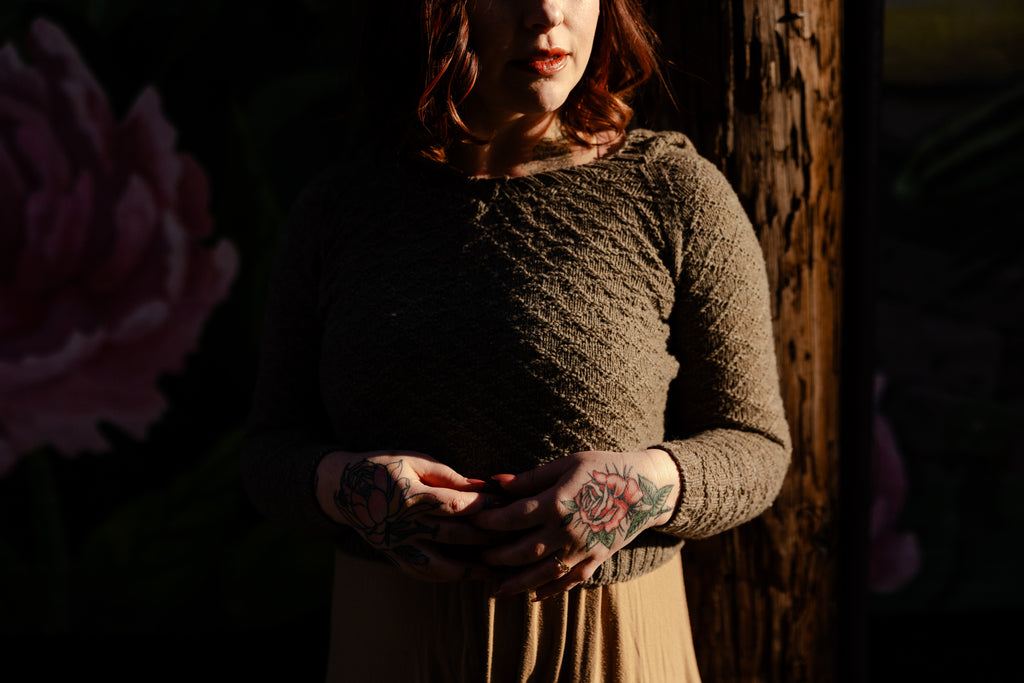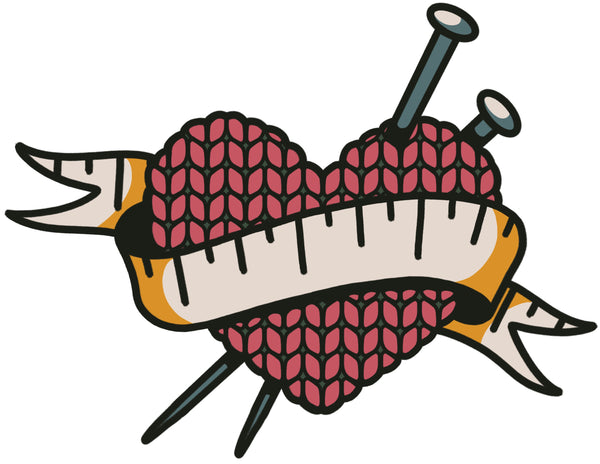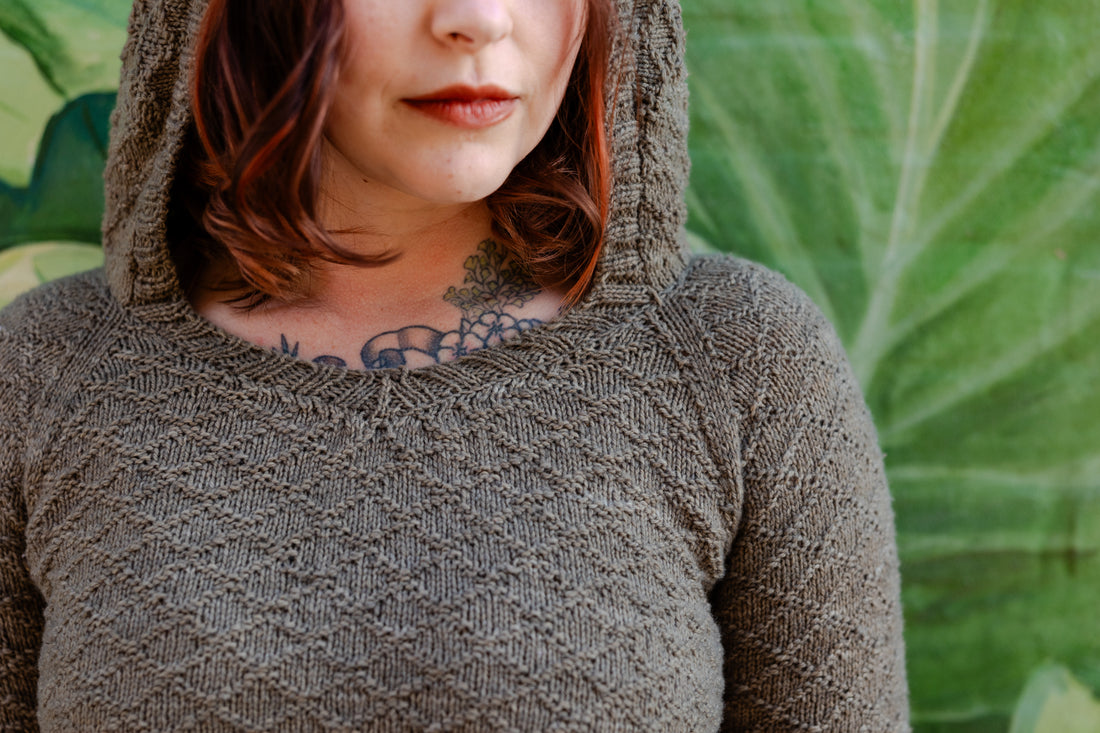Have you ever gone to cast on a sweater and found yourself smack in the middle of two sizes? Or what about when your upper chest says one thing but your upper arm circumference and hip measurement say another?
Whether it's because you aren't exactly sure what size is good for you or it's because your body is a fluid, changing thing, this week's newsletter is an exploration of sizing for in-between moments.

Knitting a Raglan?
In addition to your upper bust measurement, your upper arm measurement has a big role to play.
Read more about sizing beyond upper bust here.
Upper chest measurements are still Queen
Measure your upper chest for the most accurate sizing. One Wild Designs' patterns (save a few back catalog pieces) give you sizing guidance based on your upper chest measurement. This is the best predictor of other key fit points like your cross front, armscye depth, and upper arm circumference.
Is your upper chest measurement smack in the middle of two sizes? My best advice is to look at the ease you'll get in the full bust, hip, and upper arm measurements of both sizes according to the schematic and choose the one that gets you closest to intended ease in the most measurements.
Sometimes, upper chest is not enough
Even if your upper chest measurement doesn't place you in-between sizes, please, check the schematic! Sometimes, even if your upper arm indicates one size is best for you, fit modifications may be necessary.
In the case of a raglan or circular yoke construction, you may also wish to choose your size based on your upper arm circumference (or work with a combination of sizes). This is because the upper sleeve makes up a significant portion of the yoke in a raglan or circular yoke garment. If your upper sleeves are too tight, they'll steal some of the width from your garment.
This actually happened to me during the photoshoot for Clearly Changed. Due to stress and some gut issues, my upper arms were significantly bloated on photography day and changed the overall fit of my sweater. Thankfully this issue was temporary, and this sweater fits me great again, however, you'll notice in some of the photos that the yoke seems tight. It is!
Still, if I were to knit this sweater again, I would size up to give myself more of a cushion in case I am bloated again on another day.

Fit Top Down
The yoke (or upper chest) of a garment needs to fit well for the whole garment to fit well! That means if your upper garment is way too big or way too small, the rest of the garment will not sit well.
Add bust darts or other shaping for your lower body.
Be kind to yourself
Being kind to yourself is especially important in garment making. My experience is that self esteem issues tend to be compounded in a poorly fit sweater. While I like to remind others, and myself, that a poorly fit sweater is a great learning experience, it still sucks to feel like the thing you spent so much time on is too small.
The advice I'm taking this year is to knit a size up. Technically, my measurements place me in the smaller size still, but, because of the fluctuations of stress in my life that directly impact my gut health, it's hard to predict that I'll be this size everyday.
I know that in almost all cases, I'll be more confident with extra positive ease in a garment. I'm open to change. Maybe later this year I'll have more confidence in choosing my typical size; right now, I'm choosing grace.
Look for patterns
In some cases, you might be able to predict changes in your body seasonally due to regular lifestyle changes. If you're in a period of irregular stress or lifestyle changes that are effecting your size, you may wish to be more gracious with yourself and your sizing.
It can be intimidating to choose a size based on a pattern and not necessarily your current measurements. Still, this will be the best approach for some people to end up loving their finished garment.

Generally speaking, better too loose than too tight
There are a few cases where I would NOT recommend sizing up. For example, the Carol Bralette is a negative ease garment. If you knit this bralette with positive ease you won't be happy with the fit. There also won't be any support, making it not really a bralette. In the case of negative ease garments, I would not size up if sizing up placed me into positive ease.
Negative ease garments are designed to be stretched. Generally speaking, you may be okay with less negative ease than the pattern intends; but, you won't be okay with positive ease.
I would also be careful when sizing up a set-in sleeve garment. Set-in sleeves have a more formal appearance. In some cases, like a set-in sleeve tee shirt (like Alice), some extra width in the shoulders won't be detrimental.
It is important to note, however, that a more polished pattern like Classic Colorblock will not have the same vibe if it's knit with extra wide shoulders. With extra narrow shoulders, you'll start to see fit issues through the armscye and sleeves.
If you're in a situation like this with a set-in sleeve, you may wish to knit a larger size with narrower shoulders. On the other hand, you may wish to knit a smaller size with larger shoulders. You can check your shoulder measurement against the schematic by comparing your cross front to the garment's cross shoulder (the sum of both shoulders plus the neck).
Tips for choosing a size
Want the TL;DR? Here it is.
- Always start with upper chest. Then check the schematic for key fit points.
- For raglans, make sure your upper arm isn't stealing width from your yoke.
- For set-in sleeve garments, make sure the shoulders are not too narrow or too wide for your body. They should land right around bra strap width.
- It's much easier to add bust darts, waist or hip shaping, or remove fabric from the lower body than it is to modify armscye shaping, sleeve caps, and necklines. Still, don't be intimidated by fit modifications, one step at a time... and add a lifeline!

Your sweater knitting journey is just that
If you're newer to making garments, you are also newer to fitting them with the precision of a maker. Let each garment be a part of your journey and trust the process.
With intention, focus, and lots of patience, you can learn to size and fit yourself perfectly. We're here to help.
Join our Slack community where we talk shop with like-minded makers, or check out the One Wild Broadcast with a back library of episodes full of tips.

